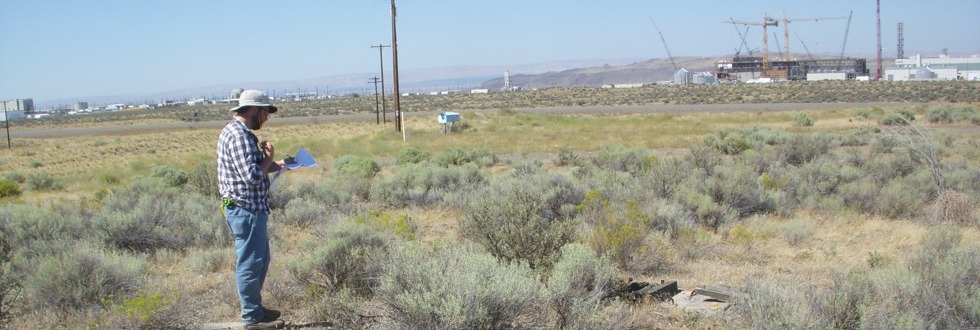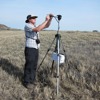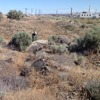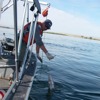Featured Projects
U.S. Department of Energy, Mission Support Alliance
Public Safety and Resource Protection – Ecological Monitoring and Compliance Project

Conducting annual wintering bald eagle surveys
The Hanford Site provides a diversity of biological communities. The site is home to at least 46 species of mammals, 10 species of reptiles, 5 species of amphibians, over 200 species of birds, well over 1,000 species of insects and invertebrates, and approximately 700 species of plants. Forty-six fish species have been identified in the Hanford Reach of the Columbia River, as well as numerous insects, crayfish, and mollusks.
Federal and state resource management agencies consider many of these species and associated habitats to be rare or of special concern. Federal laws, regulations, and Executive Orders protect ecological resources on the site, including the Endangered Species Act, National Environmental Policy Act, Migratory Bird Treaty Act, and Bald and Golden Eagle Protection Act.
EAS assists DOE ensure its activities are in compliance with these and other requirements through the Ecological Compliance Project, part of the Public Safety & Resource Protection program. Specifically, EAS responsibilities and support functions to this project are to:
- Conduct ecological compliance reviews to determine if proposed contractor activities will adversely impact biological resources and provide recommendations to reduce environmental impacts
- Facilitate Sections 7 & 10 consultations required by the Endangered Species Act with federal and state regulatory agencies and stakeholders
- Define and map habitats and species distribution for land-use planning
- Perform baseline surveys and monitor compliance with applicable requirements
- Maintain a database on the regulatory status and distribution of species and habitats
- Develop natural resource management plans to minimize the impacts of site operations on ESA-listed flora and fauna (including salmonids).
U.S. Department of Energy, Bonneville Power Administration
Assessing Potential Biological Impacts from Transmission Line Rebuild

Documenting rare species and habitats in the shrub-steppe ecosystem
Electric power producers are required to ensure transmission systems have adequate capacity to serve customers safely and that potential impacts to special-status species of plants, wildlife, and habitats be assessed before renovating or constructing systems.
As part of a power line rebuild project, the EAS team conducted extensive walk-downs of the project area, totaling 39 miles, to document rare plants, animals, and habitats. The purpose of these surveys was to assess impacts related to replacing aging power poles and transmission lines and installing new ones on DOE-managed lands. Surveys targeted priority flora and fauna including Columbia milkvetch, shrub-steppe-dependent species such as sage sparrows and loggerhead shrikes, and black-tailed jackrabbits. We worked with DOE and the client to develop a technically feasible strategy to reduce habitat impacts according to the Hanford Site Biological Resources Management Plan.
ProSource Technologies Inc. & Cascade Natural Gas
Assessing Potential Biological Impacts from Pipeline Construction
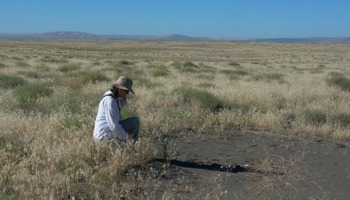
Locating occurrences of priority species and habitats in the project area
To reduce fuel costs and greenhouse gas emissions, DOE has proposed to make natural gas available to Hanford Site facilities. In support of a biological assessment, the EAS team conducted botanical and wildlife surveys to identify and quantify potential environmental impacts of constructing, operating, and maintaining a natural gas transmission line on DOE and non-DOE lands. Surveys also were conducted to verify and update baseline information included in the Biological Resources Management Plan (BRMP).
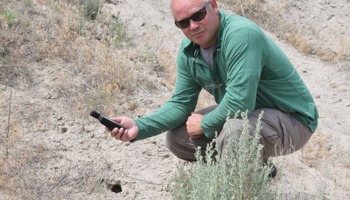
Monitoring ground squirrel colonies
To adequately assess potential project disturbances EAS team botanists focused on locating and documenting occurrences of BRMP-defined priority species and habitats in the study area. State conservation species located included Coyote tobacco, Thompson’s sandwort, and hairy bugseed. Wildlife teams documented locations of burrowing owl nests and ground squirrel colonies along the proposed 30-mile-long corridor. Specialists also documented significant aggregations of special-status butterflies and invertebrates and a relative abundance of sagebrush lizards in the study area using GPS points or polygons.
U.S. Department of Energy, Mission Support Alliance
Migratory Bird Protection Act Compliance

Protecting federally threatened and endangered hawks
The Hanford Site supports a large and diverse community of migratory birds, including swallows, hawks, eagles, and passerine birds that may nest on or near facilities being demolished or constructed on the site. Several of these species are listed as federally threatened and endangered, including ferruginous hawks, Swainson’s hawks, bald eagles, and burrowing owls.
The Migratory Bird Treaty Act and Bald and Golden Eagle Protection Act both protect these species. In addition an Executive Order requires federal agencies to reduce existing or potential adverse impacts to migratory birds and their habitats, restore or enhance bird habitat, and incorporate conservation of migratory birds and habitat into federal agency plans, guidance, or activities.

Monitoring state-listed burrowing owls
EAS conducts surveys of migratory species on the Hanford Site to document nest locations and track populations over time. In 2012, we identified 107 raptor and raven nests on the Hanford Site, most of which were located on transmission towers, utility poles, and planted trees. EAS uses nest location information to work with cleanup and remediation project staff to avoid disturbing nests during egg laying or incubation, relocate nests, as authorized by state or federal permits, or establish barriers between bird nesting areas and project operations.
Although DOE and the Washington Department of Fish and Wildlife have conducted surveys of nesting raptors on the Hanford Site since 1973, these surveys were not conducted systematically. The monitoring locations and timing of the surveys were inconsistent and documented different subsets of raptors. In 2012, working with MSA, EAS staff initiated a consistent and reproducible approach for long-term monitoring of nesting raptors for the portions of the Hanford Site managed by DOE-RL.
Mission Support Alliance has publically released several reports related to ecological monitoring and compliance on the Hanford Site, including the following:
- Hanford Site Burrowing Owl Monitoring Report for Calendar Year 2013, MSA, HNF-56531 Revision 0
- Burrowing Owl Monitoring Report for Calendar Year 2012, MSA, HNF-54294 Revision 0
- Hanford Site Raptor Nest Monitoring Report for Calendar Year 2013, MSA, HNF-56769 Revision 0
- Raptor Nest Monitoring Report for Calendar Year 2012, MSA, HNF-53073 Revision 0
The reports can be found at: http://www.hanford.gov/page.cfm/EcologicalMonitoring
Grant County Public Utility District
Determining the Effectiveness of Bird Flight Diverters on Transmission Lines

Estimating bird abundance and response to BFDs
As the demand for electricity continues to grow, power producers are building or rebuilding networks of transmission lines to meet the need. Increasingly, power lines have contributed to the deaths of millions of birds, including eagles, owls, and hawks. Power producers are now retrofitting existing power lines and installing new equipment to conserve bird species.
EAS is working with the Grant County Public Utility District as part of a long-term project to determine the effectiveness of bird flight diverters in reducing the chance of birds colliding with overhead transmission lines. Per a Federal Energy Regulatory Commission (FERC) order, Grant County PUD is required to install bird flight diverters (BFDs) on 10 transmission line spans within five transmission line corridors from 2011–2015; conduct avian surveys from 2011–2016 and every 15 years thereafter; and provide annual reports to the U.S. Fish and Wildlife Service, Washington Department of Fish and Wildlife, and FERC.
For this project, EAS conducts avian surveys, performs data quality assurance, and provides data summary reports to the client to estimate bird relative abundance and bird response to the BFDs. By integrating the flight patterns of various bird species and the estimated number of bird-strikes, data from these surveys will help quantify the efficacy of the BFDs.
U.S. Department of Energy, Mission Support Alliance
Protecting Bald Eagle Habitat

Monitoring bald eagle use of protected roost locations and nest sites
Although bald eagles are no longer listed as a federally threatened and endangered species, federal laws, including the Bald and Golden Eagle Protection Act and the Migratory Bird Treaty still provide protection for eagles, their nest trees, and communal night roosts. Bald eagles occur on the Hanford Site primarily during the winter months when they congregate to feed on fall Chinook salmon carcasses that wash up along the shores of the Columbia River and waterfowl that winter in the area.
EAS works with MSA to monitor bald eagles on the Hanford Site. We conduct annual bald eagle surveys to monitor bird use of currently protected roost locations and nest sites and document current and potential night roosts and nest sites along the Hanford Reach. We also conduct boat surveys to determine the age class, distribution, and abundance of eagles wintering along the Hanford Reach. During winter 2012-2013, EAS staff conducted 220 bald eagle surveys, including 208 night roost surveys, 3 boat surveys, and 9 nest site surveys. Although pairs of bald eagles have attempted to nest on the Hanford Site, no successful nest was documented until 2013. Working with MSA and DOE-RL, EAS established barricades around the nest site and helped protect the nesting pair from project operations. The eagle pair successfully fledged two young during 2013.
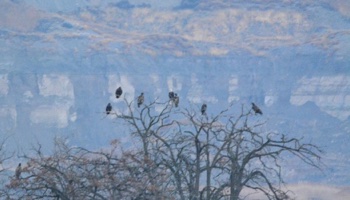
Determining the numbers of eagles present at night roosts
Monitoring bald eagles on the Hanford Site is essential to maintain current biological information on abundance and distribution on the site, ensure compliance with regulatory requirements, and inform future management decisions.
The DOE Public Safety & Resource Protection Program has publically released reports on bald eagle monitoring since 2012, including the following:
- Hanford Site Bald Eagle Monitoring Report for Fiscal Year 2014, MSA, HNF-58547 Revision 0
- Hanford Site Bald Eagle Monitoring Report for Fiscal Year 2013, MSA, HNF-55187 Revision 0
- Bald Eagle Monitoring Report for Fiscal Year 2012, MSA, HNF-52464 Revision 0
The reports can be found at: http://www.hanford.gov/page.cfm/EcologicalMonitoring
U.S. Department of Energy, Bonneville Power Administration
Identifying Invasive, Noxious Weeds to Eradicate and Control Species

Identifying and mapping invasive plants and noxious weeds
Invasive plants and noxious weeds are primary threats to biological diversity. Next to habitat destruction, more than 50% of the loss of native biodiversity globally has been attributed to invasive species, and nearly half of the species listed as threatened or endangered are at risk due to competition with alien or introduced rivals.
The EAS team performed a pre-construction noxious weed survey for an electric power transmission line rebuild project between Grand Coulee and Creston, Washington, as part of a federal Environmental Assessment. The proposed project would replace all wood-pole structures, improve existing access roads, and develop temporary access roads. Rebuilding the line would help maintain reliable electrical service and avoid risks to the safety of the public and maintenance crews.
We conducted field surveys to identify invasive plants and noxious weeds, photograph and map their locations, and determine population density. We also reported problems related to the identified species in terms of methods of propagation and spreading and recommended methods to eradicate and control the species.
U.S. Department of Energy, Mission Support Alliance
Cultural and Historic Resources Program (C&HRP)
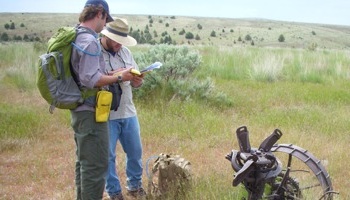
Performing National Historic Preservation Act Section 106 reviews
The Hanford Site contains numerous archeological and historical sites and districts, traditional cultural properties, and artifacts dating from approximately 11,000 years ago to the present. EAS works with MSA to ensure site compliance with federal cultural resources laws and regulations. We provide qualified cultural resource staff and support personnel with an extensive knowledge of Hanford prehistoric and historic periods.
Specifically, EAS responsibilities and support functions to the C&HRP are to:
- Maintain procedures to ensure DOE compliance with National Historic Preservation Act, American Indian Religious Freedom Act, Archaeological Resources Protection Act, Native American Graves Protection and Repatriation Act, and other applicable cultural resources, laws, regulations, and DOE directives
- Meet professional standards under regulations developed by the Secretary of the Interior - Professional Standards and Guidelines (36 CRF Part 61)
- Implement National Historic Preservation Act Section 106 reviews for Hanford Site contractors that incorporate the NHPA Section 106 criteria and guidance, but also may include literature reviews, surveys, subsurface testing, excavation, monitoring, GIS mapping and analysis, and artifact analysis. As part of Section 106 reviews, EAS also records archaeological sites; updates site forms; completes Determinations of Eligibility; and prepares Memoranda of Agreement, cultural resource monitoring plans, and technical reports.

Documenting historic resources on the Hanford Site
